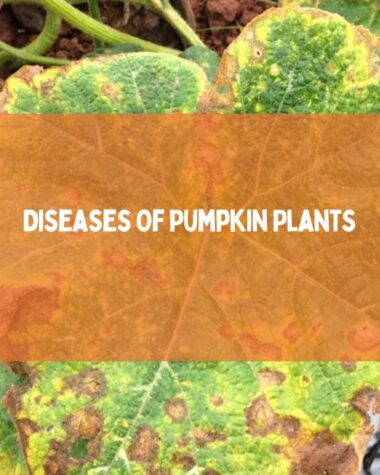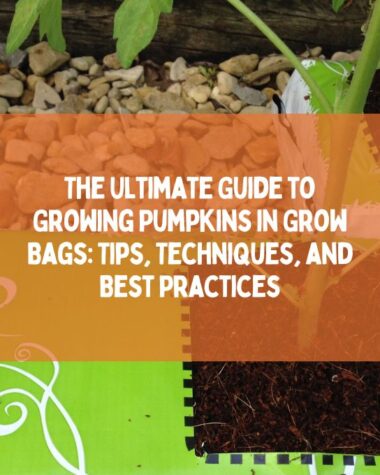Pumpkin mosaic virus (PMV) is a harmful plant virus that affects various members of the Cucurbitaceae family, including pumpkins, squash, and cucumbers. PMV is known to cause significant damage to crops, leading to reduced yields and economic losses for farmers.
Mosaic viruses are a group of plant viruses that cause characteristic mosaic patterns on the leaves of infected plants, stunted growth, and reduced fruit quality. Although there is no cure for mosaic virus, you can adopt disease management strategies to protect cops.
This article provides you with comprehensive information about PMV, including its prevention, mosaic types, symptoms, treatments, and disease management strategies.
Let’s move on.
Life Cycle of a Pumpkin Mosaic Virus

The life cycle of a mosaic virus begins when it enters a plant, either through vectors like aphids or direct contact with infected plant tissues. Once inside the plant, the virus replicates within the infected cells and spreads to other tissues and organs through the plant’s vascular system.
This leads to the development of characteristic symptoms such as mosaic patterns on the leaves, vein clearing, and stunted growth. The virus can also be transmitted to new plants when vectors feed on infected plants and then move on to healthy ones, injecting the virus into their cells.
Symptoms And Signs of Pumpkin Mosaic Viruses on Plants
Mosaic viruses can cause a variety of symptoms on pumpkin plants.
Here are the common signs and symptoms:
- Mosaic Patterns: The symptom of mosaic viruses on pumpkin plants is the appearance of mosaic patterns on the leaves. These patterns consist of irregular patches and are dark green, yellow, or white, giving the leaves a mottled appearance. The mosaic patterns can vary in intensity and distribution.
- Vein Clearing: Another characteristic symptom is the clearing or lightening of the veins on the leaves. The veins may appear lighter or even white, while the areas between the veins remain green.
- Leaf Distortion: Infected pumpkin plants may exhibit leaf distortion, which can include curling, cupping, or puckering of the leaves. The leaves may become misshapen or show irregular growth.
- Stunted Growth: Mosaic viruses can lead to stunted growth in affected plants. Infected pumpkins may be smaller in size compared to healthy plants, and their overall growth and development may be delayed.
- Reduced Fruit Quality: Mosaic viruses can have a negative impact on pumpkin fruit quality. Infected fruits may show deformities, discoloration, or uneven ripening. They may also be smaller in size or have a rough surface.
It is important to note that mosaic symptoms can vary depending on the specific mosaic virus affecting the plant, environmental conditions, and the stage of infection. Other factors, such as nutrient deficiencies, herbicide damage, or physical trauma, can also produce mosaic-like symptoms.
Related Reading
- 14 Best Varieties Of Pumpkins You Should Know
- How To Make Pumpkins Grow Faster?
- Pumpkin Water Requirements: How Much Do Pumpkins Need?
- How To Grow Pumpkins – A Step-by-step Guide
Types Of Mosaic Virus That Affects Crops

There are several types of mosaic viruses that can affect a wide range of crops, including pumpkins, cucumbers, tomatoes, and peppers.
Here are some common types of mosaic viruses:
1. Cucumber Mosaic Virus (CMV)
CMV is one of the most widespread mosaic viruses, affecting various plants, including pumpkins and cucumbers. It causes mosaic patterns on leaves, stunted growth, and reduced fruit quality. Aphids are the primary source of CMV transmission, but it can also spread through contaminated tools or plant sap.
2. Tobacco Mosaic Virus (TMV)
TMV primarily affects tobacco plants but can also infect other crops such as tomatoes, peppers, and cucumbers. It causes distinct mosaic patterns on leaves, along with leaf distortion and reduced plant vigor. TMV is highly contagious and can be transmitted through direct contact or even human touch.
3. Squash Mosaic Virus (SqMV)
SqMV affects various squash plants, including pumpkins and zucchini. It causes mosaic patterns on leaves, stunted growth, and reduced fruit quality. SqMV is transmitted through aphids and can also spread through infected plant debris.
4. Watermelon Mosaic Virus (WMV)
WMV affects watermelon plants and causes mosaic patterns on leaves, as well as yellowing and stunting. It can also lead to reduced fruit size and quality. Aphids spread WMV, which can persist in weed hosts and endanger watermelon crops.
5. Zucchini Yellow Mosaic Virus (ZYMV)
ZYMV primarily affects zucchini plants but can also infect other cucurbits. It causes yellow mosaic patterns on leaves, stunted growth, and reduced fruit production. ZYMV is primarily transmitted through aphids.
These are just a few examples of mosaic viruses that commonly affect crops. Each virus has its own specific host range and transmission mechanisms, but they all share the characteristic symptom of mosaic patterns on infected leaves.
Disease Management Strategies of Mosaic Virus

Disease Management Strategies for Pumpkin Mosaic Virus:
1. Plant Resistant Varieties
Selecting and planting pumpkin or squash varieties that have been bred for resistance to Pumpkin Mosaic Virus (PMV) can be an effective management strategy. These resistant cultivars have genetic traits that make them less susceptible to the virus and can help minimize the impact of the disease on crop production.
2. Sanitation Practices
Implementing good sanitation practices is crucial to managing PMV. Remove and destroy any infected plant debris, including leaves, stems, and fruits. This helps reduce the chances of disease spreading. Remove weeds and volunteer plants from the field, as they can serve as alternative hosts for PMV.
3. Vector Control
Aphids and other insect vectors are primarily responsible for spreading PMV. Implementing strategies to control aphids can help manage the virus. Monitor the aphid populations regularly and apply appropriate insecticides or biological control methods to reduce their numbers. Yellow sticky traps placed strategically in the field can also help capture and control aphids.
4. Crop Rotation
Practicing crop rotation by avoiding planting cucurbits in the same area for consecutive seasons can break the virus’s life cycle. PMV cannot survive for long periods in the absence of susceptible host plants, so rotating with non-host crops helps reduce the virus’s population in the field.
5. Virus-Free Seed
Use certified virus-free seeds obtained from reputable sources. Planting virus-free seeds reduces the risk of introducing PMV into your crop. Be cautious when saving seeds from infected plants, as the virus can be transmitted through seeds.
6. Reflective Mulches
Using reflective mulch, such as silver-colored plastic, around the base of the plants can deter aphids from landing on the plants. The reflective surface disorients and repels the insects, reducing the chances of virus transmission.
7. Integrated Pest Management
Implementing an IPM approach is beneficial for managing PMV. This involves combining various strategies, including cultural, biological, and chemical control methods, to keep the disease under control while minimizing the use of pesticides.
8. Control Aphid Vectors
Since aphids are the primary vectors for mosaic viruses, implementing measures to control their population is important. Use insecticides, apply insecticidal soaps or oils, or introduce natural predators of aphids to help reduce their numbers.
9. Use Virus-Free Seeds
Plant certified virus-free seeds obtained from reputable sources to reduce the risk of introducing mosaic viruses into your pumpkin crop. Ensure that the seeds have been tested and certified to be free from viral infections.
- A combination of preventive measures and timely management practices is essential for effective disease control and maintaining healthy pumpkin crops.
How Do Plants Get Mosaic Virus?
Plants can get mosaic viruses through various means.
Here are the main ways plants can become infected with mosaic viruses:
- Insect vectors: Particularly aphids, insect vectors frequently spread mosaic viruses. These tiny insects feed on infected plants and acquire the virus from the sap. When they move on to feed on healthy plants, they can transmit the virus through their mouthparts. Other insect vectors, such as whiteflies and leafhoppers, can also transmit mosaic viruses.
- Contaminated Tools and Equipment: Mosaic viruses can be spread through contaminated tools and equipment. If gardening tools, pruning shears, or other equipment are used on infected plants and then used on healthy plants without proper cleaning, the virus can be transferred.
- Sap Contact: Mosaic viruses can be spread through direct contact between infected and healthy plants. If sap from an infected plant comes into contact with a healthy plant’s damaged tissues, the virus can enter and infect the healthy plant.
- Seed Transmission: In some cases, mosaic viruses can be transmitted through infected seeds. If the mother plant was infected, the virus can be present in the seed. Planting infected seeds can result in the transmission of the virus to the new plants.
- Weed Hosts: Mosaic viruses can also survive and multiply in weed hosts. Weeds belonging to the same plant family as the infected crop can harbor the virus and serve as a reservoir. When the weed hosts are in close proximity to the crop, aphids or other vectors can transmit the virus from the weeds to the healthy plants.
Pumpkin Yellow Mosaic Virus

Pumpkin Yellow Mosaic Virus (PYMV) is a plant virus that affects pumpkins and other members of the Cucurbitaceae family. It is responsible for causing significant damage to crops worldwide. PYMV belongs to the Potyvirus genus and is transmitted primarily through aphids, which act as vectors for the virus.
Symptoms
Common symptoms of pumpkin yellow mosaic include:
- Infected plants exhibit a yellow mosaic pattern on their leaves. The mosaic pattern consists of irregular yellow patches or streaks on a green background.
- Infected plants often show reduced and stunted growth compared to healthy plants.
- Leaves may become distorted, curled, or wrinkled as a result of the virus infection.
- PYMV can lead to decreased fruit set, resulting in poor yields. Infected fruits may exhibit deformities, discoloration, and reduced size.
Transmission and Spread
The Pumpkin Yellow Mosaic Virus is transmitted through aphids. These aphids feed on infected plants and acquire the virus, subsequently transmitting it to healthy plants as they move and feed on them.
Related Reading
- Can You Eat Deformed Zucchini?
- Why Cats Are Afraid of Cucumbers? The Surprising Truth Revealed!
- Tomato Plant Care: A Brief Guide to Growing and Nurturing Healthy Tomatoes
- What Is the Best Time to Plant Carrots?
Conclusion
Pumpkin Yellow Mosaic Virus is a significant threat to cucurbit crops, including pumpkins. It causes characteristic yellow mosaic patterns on leaves, stunted growth, and reduced fruit quality.
By implementing preventive measures like using virus-free seeds, controlling aphid populations, practicing crop rotation, and planting resistant varieties, farmers can minimize the impact of PYMV and protect their crops.
Proper diagnosis by a plant pathologist or agricultural expert is crucial to accurately identifying the presence of mosaic viruses in pumpkin plants.







